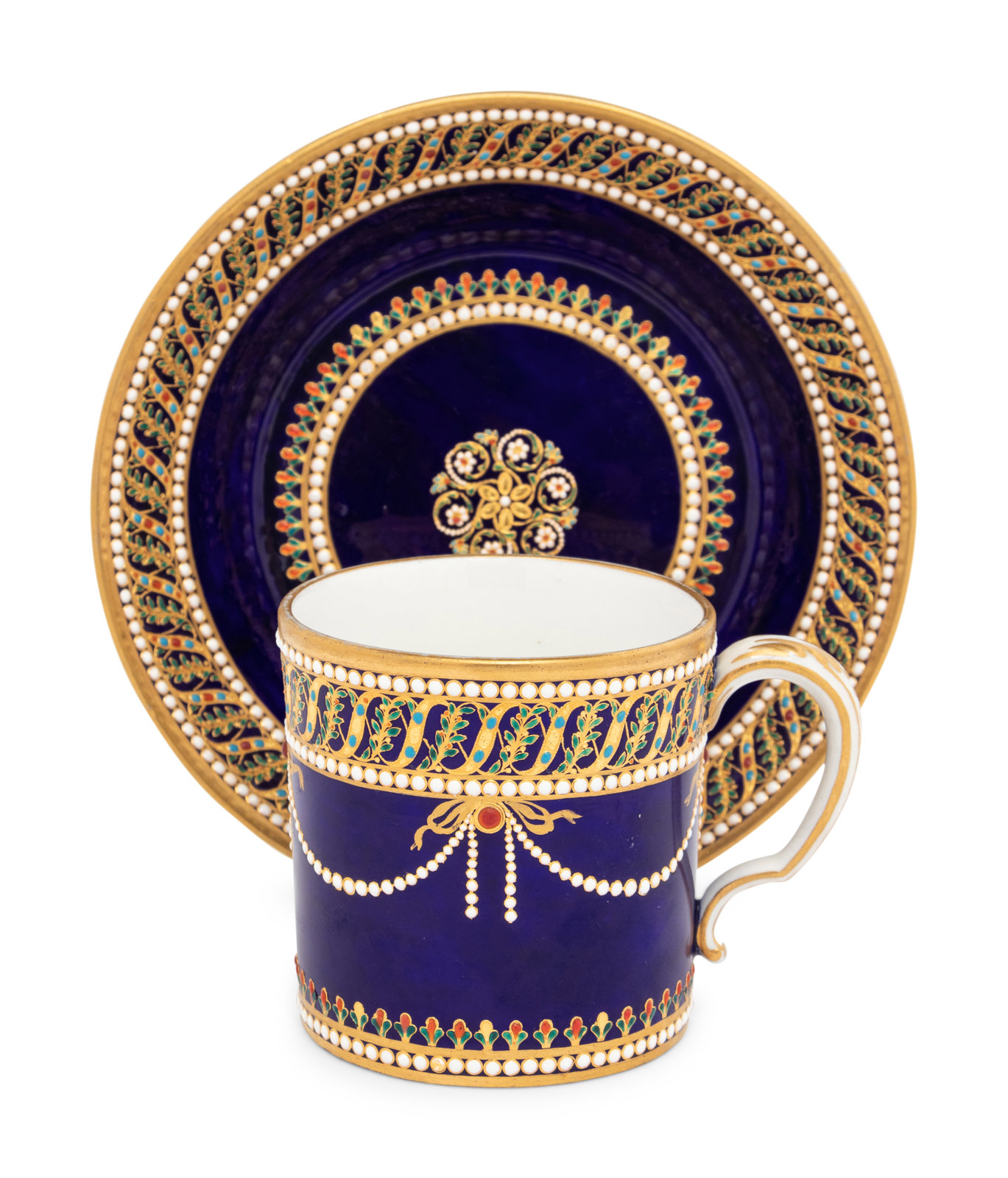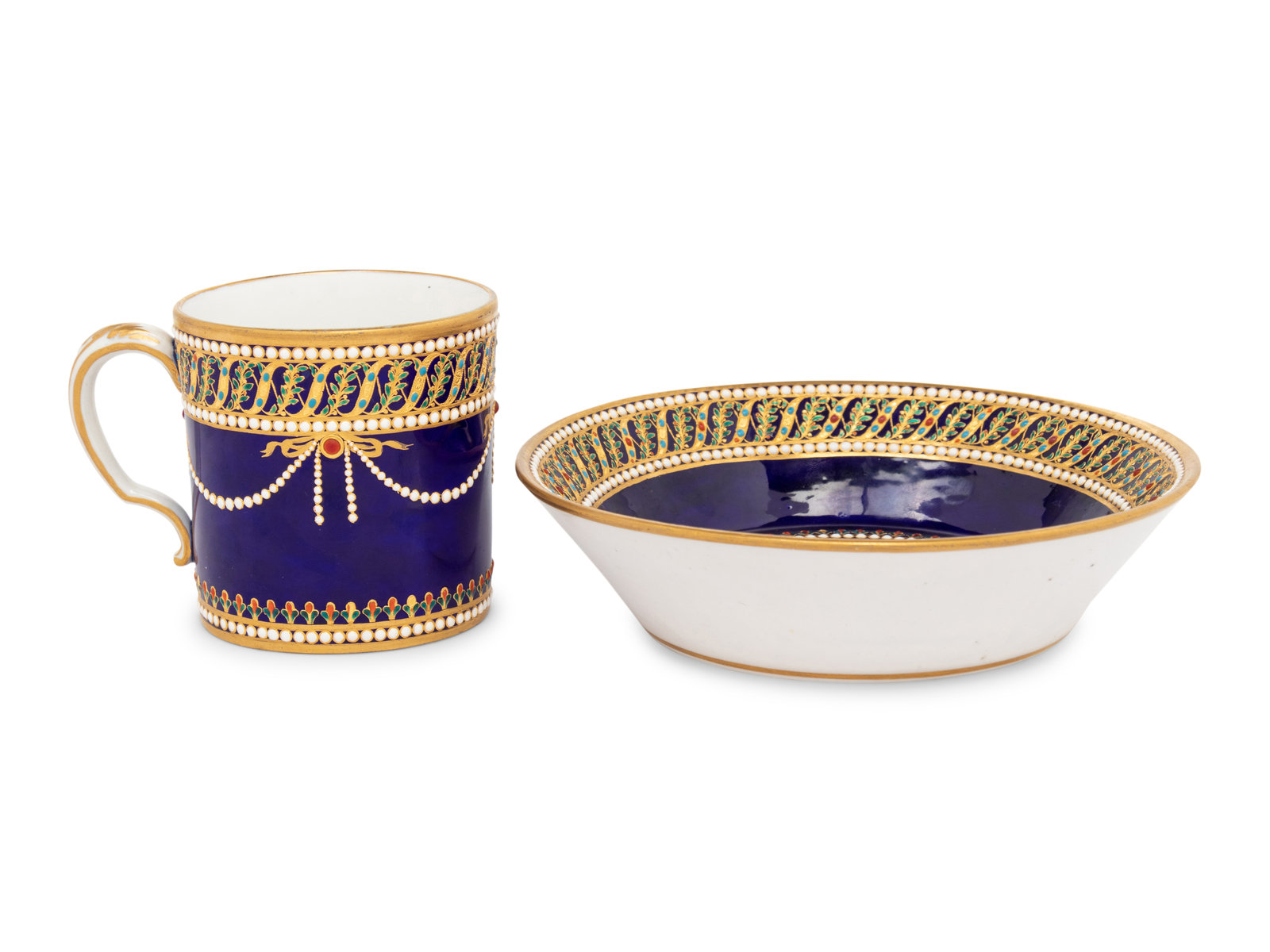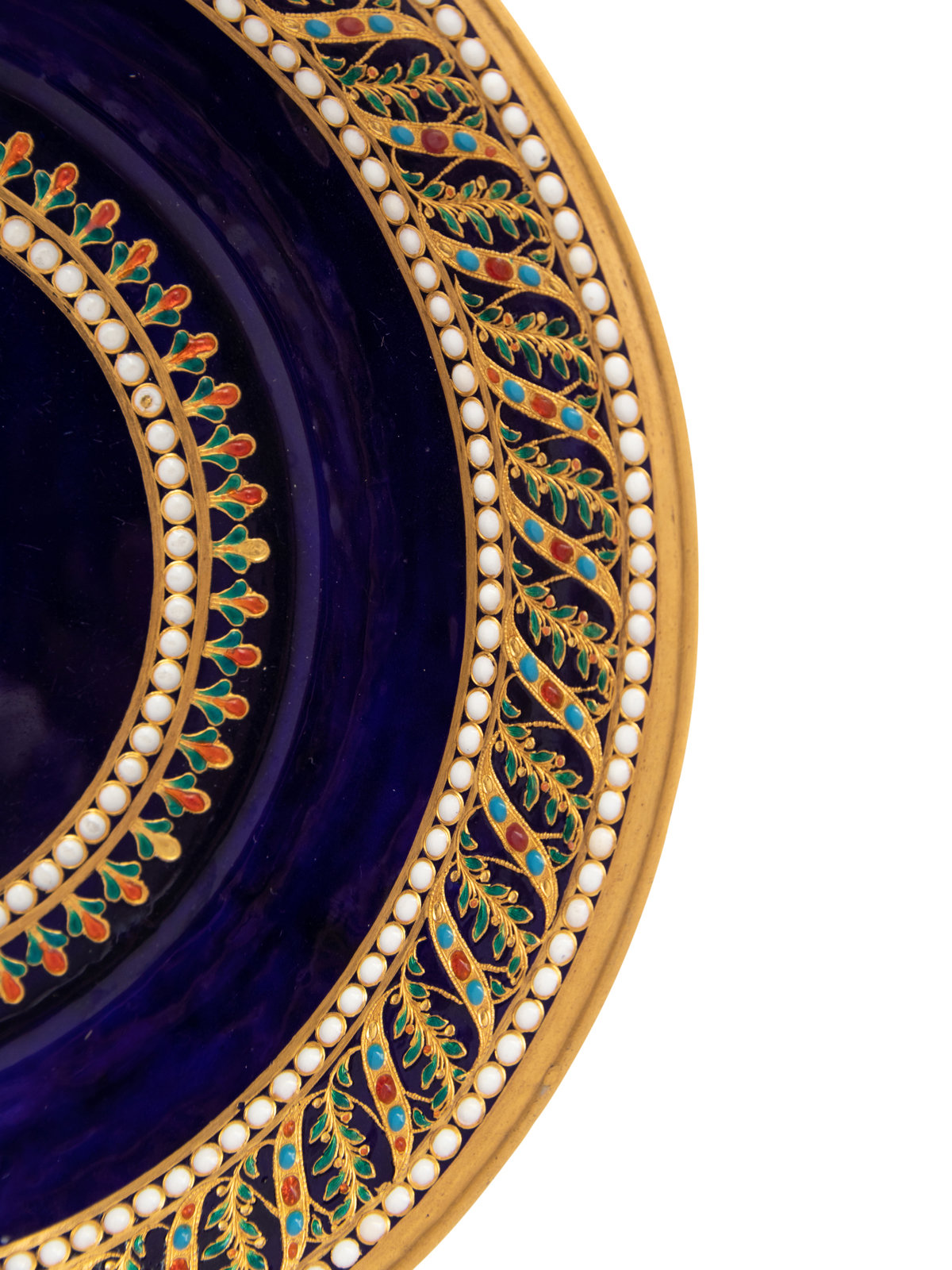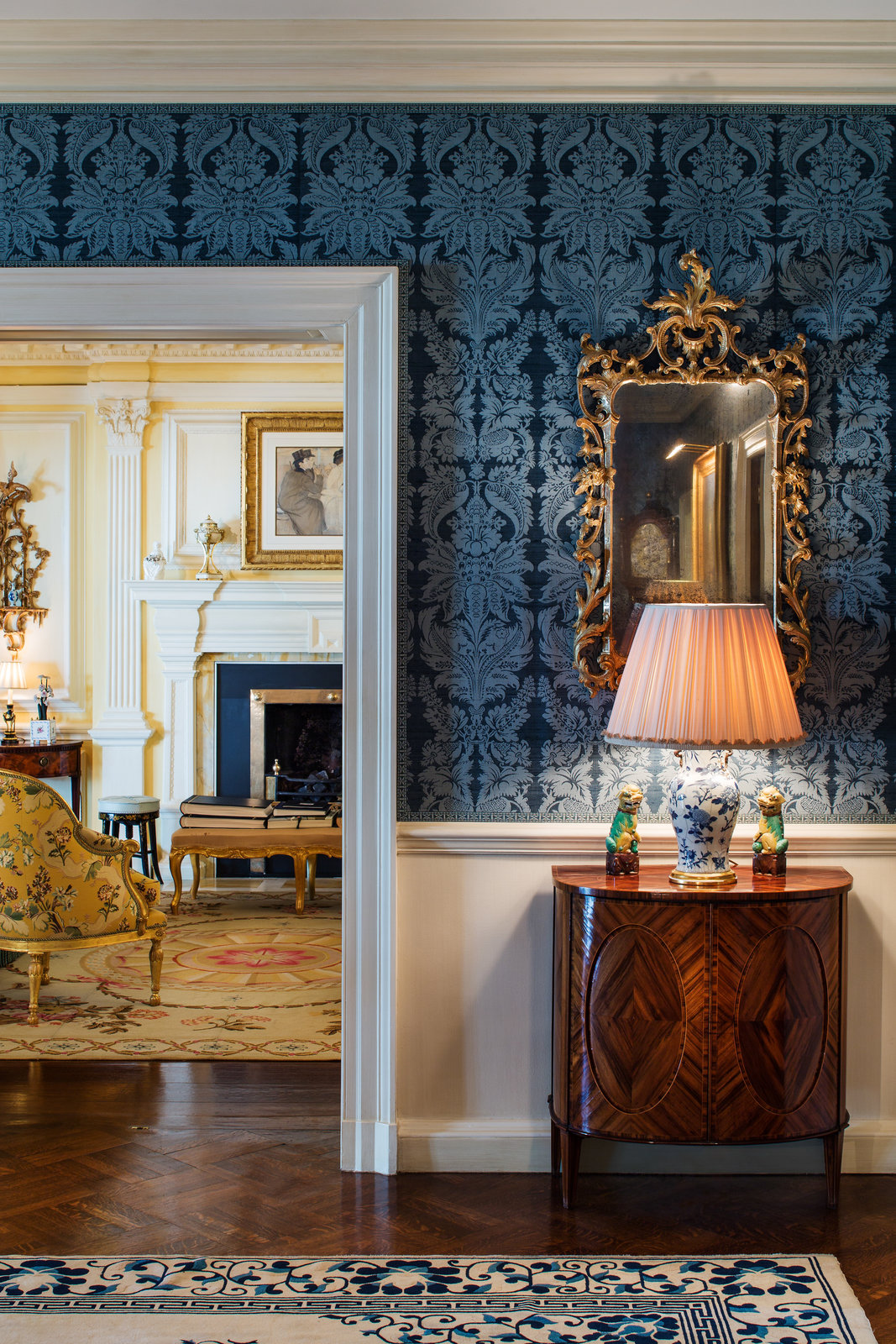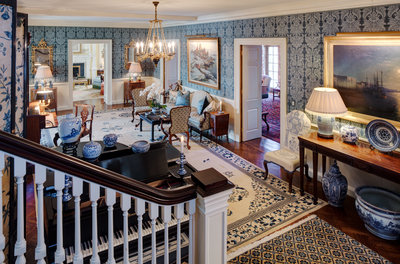A Sèvres Partially Beau Bleu Jewelled Porcelain Coffee Can and Saucer (Gobelet 'Litron' et sa Soucoupe, 1ère Grandeur)
Sale 1157 - Property from the Fred and Kay Krehbiel Collection, Part I
Mar 15, 2023
10:00AM CT
Live / Chicago
Estimate
$3,000 -
$5,000
Sold for $21,420
Sold prices are inclusive of Buyer’s Premium
Lot Description
A Sèvres Partially Beau Bleu Jewelled Porcelain Coffee Can and Saucer (Gobelet 'Litron' et sa Soucoupe, 1ère Grandeur)
The Porcelain Circa 1782
both bearing gilt interlaced Ls mark flanked by date letters ee above decorator’s mark L. for L’Ecot, the cup further incised 73, the saucer incised 38A; jewelled between bands of white enamel ‘pearls’ with a wide band of gilt foil interlaced S-scrolls enriched with turquoise and red cabochons, the cup with gilt ribbon-tied white beaded swags suspended from the band running around the mouth of the cup, the saucer with a central medallion.
Height of cup 2 7/8 inches; diameter of saucer 6 1/8 inches.
Height of cup 2 7/8 inches; diameter of saucer 6 1/8 inches.
This lot is located in Chicago.
Provenance:
Drouot, Paris, Anonymous sale, 23 October 1996, Lot 71
Dragesco-Cramoisan, Paris, June 1997 (purchased at the International Ceramics Fair, London)
Note:
Introduced at Sèvres circa 1779, jewelling was at the height of its popularity during the early years of the 1780s. It was an extremely laborious and, therefore, expensive process resulting in an exceptionally delicate finished product.
Making the ‘jewels’ involved the application of drops of enamel in imitation of precious stones—opaque white for pearls, translucent blue, red and green for sapphires, rubies and emeralds, ochre for topaz, purple for amethyst, etc.—onto gold foils stamped by steel dies and then engraved and tooled in shallow relief with star bursts and other patterns, these tooled patterns remaining visible through the translucent enamel, giving depth to the ‘cabochons’.
Applied in the eighteenth century to both hard- and soft-paste porcelain, jewelling was used at Sèvres in combination with a wide range of ground colors. In addition to the rich blue (beau bleu) of the present example, undoubtedly the most popular and successful ground color, examples are known on green, bleu céleste, lapis lazuli, black, merde d’oie (an olive green), boue de Paris (a taupe-beige), mauve, red, lilac, and maroon grounds, as well as on white, perhaps the least successful.
One other jewelled beau bleu cup and saucer of 1782 virtually identical in decoration to the present example is known. It has been in the British Royal Collection since 1907 and is currently on display at Windsor Castle in the Green Drawing Room (Sir Geoffrey de Bellaigue, French Porcelain: In the Collection of Her Majesty the Queen, London, Vol. II, cat. no. 216, pp. 828-830, inv. 58189a-b). The cup has the same capital L mark for Louis-François L’ Écot (active 1761-1764 and 1772-1800), one of the few decorators at the factory skilled in jewelling. Recorded as a gilder and painter, he also specialized in chinoiseries and arabesques. Its saucer, with a variant central medallion and a different date letter, has been identified by de Bellaigue as a later replacement.
Catalogue entry no. 216 references two other bleu nouveau examples known on the Paris art market in the mid-1990s. These are, in fact, one example—the present cup with its original saucer. A third cup and saucer with the same jewelling pattern but on a bleu céleste ground was in the collection of René Fribourg, sold The René Fribourg Collection – V: French Faience and European Porcelain, Part II, Sotheby’s, London, 15 October 1963, lot 434.
Condition Report
In generally good condition. The cup lacking most of the red enamel ‘cabochons’ on the S-scrolls, revealing the tooled foil beneath. Several also lacking on the row of ‘lollipop’ flowers running around the foot. The saucer also lacking some red enamel on the band of lollipop flowers enclosing the central rosette and rinceau. The saucer with a small pit on rim, likely from production. Examination under UV light does not show evidence of repair. Additional images available upon request.
Condition reports are available upon request. All lots are sold “as is,” in the condition they are in at the time of the auction. The physical condition of lots can vary due to age, normal wear and tear, previous damage, and restoration. Prospective buyers are strongly advised to inspect a lot personally or through a knowledgeable representative prior to bidding. The absence of any reference to the condition of a lot does not imply that the lot is in perfect condition or completely free from wear and tear, imperfections, or the effects of aging. Prospective buyers must review and agree to the Conditions of Sale before participating in an auction, and it is the responsibility of the buyer to ensure that they have requested, received and considered any condition report.
Condition reports are available upon request. All lots are sold “as is,” in the condition they are in at the time of the auction. The physical condition of lots can vary due to age, normal wear and tear, previous damage, and restoration. Prospective buyers are strongly advised to inspect a lot personally or through a knowledgeable representative prior to bidding. The absence of any reference to the condition of a lot does not imply that the lot is in perfect condition or completely free from wear and tear, imperfections, or the effects of aging. Prospective buyers must review and agree to the Conditions of Sale before participating in an auction, and it is the responsibility of the buyer to ensure that they have requested, received and considered any condition report.
The physical condition of lots in our auctions can vary due to
age, normal wear and tear, previous damage, and
restoration/repair. All lots are sold "AS IS," in the condition
they are in at the time of the auction, and we and the seller make
no representation or warranty and assume no liability of any kind
as to a lot's condition. Any reference to condition in a catalogue
description or a condition report shall not amount to a full
accounting of condition. Condition reports prepared by Hindman
staff are provided as a convenience and may be requested from the
Department prior to bidding.
The absence of a posted condition report on the Hindman website or
in our catalogues should not be interpreted as commentary on an
item's condition. Prospective buyers are responsible for
inspecting a lot or sending their agent or conservator to inspect
the lot on their behalf, and for ensuring that they have
requested, received and understood any condition report provided
by Hindman.
Please email europeanfurniture@hindmanauctions.com for any additional information or questions you may have regarding this lot.
